Larry relaxes after picking up bottles. Rolls a cigarette. Kicks back.
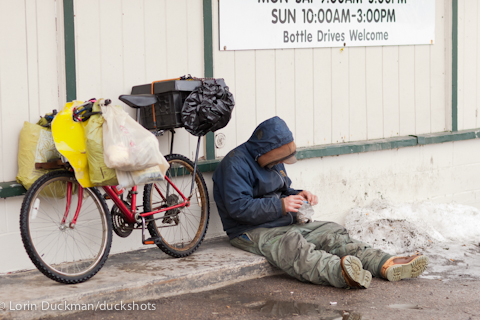
He said his brother died last spring. He took over the bottle business. “You should see me with a full load.”
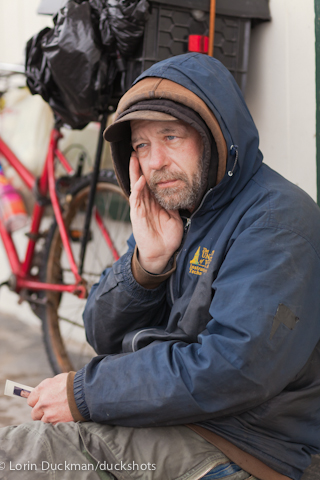
He does what he has to do to survive.
Photography Thinks
He stands tall, despite the cold. Undervalued, underused, and under appreciated. But he doesn’t give up.
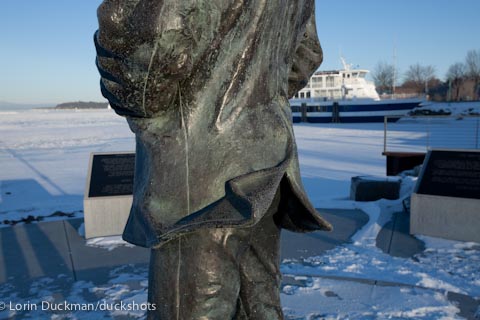
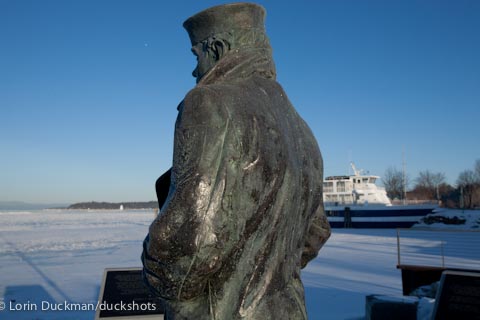
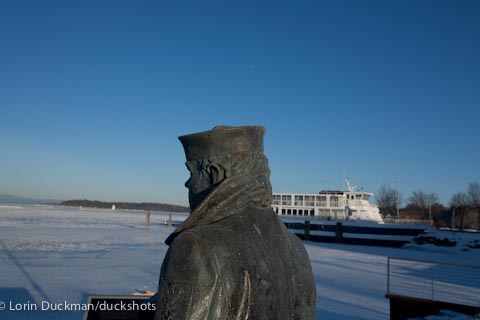
I saw her on a milk crate near Ben and Jerry’s. She looked young, cold, and sad. “Need some food,” I asked? “I need cat food,” she replied. I gasped, immediately thinking she would eat cat food as a tuna substitute. “Do you have enough money for food?” “Yeh, my boyfriend gets SSI and we do a little work, but its barely enough to cover rent and food. I don’t usually come out her to sit. I just need some money to feed my three cats.”
Never had a solo show. Well, maybe this wasn’t. Shared the space with another artist.
Sanders Watson had houses without people, ironically from Queens. I had people without houses and people who would never be allowed in some houses if they dressed as I saw them on the street. Carinda Swann curated the show, coming up with the name, writing the gallery director’s statement, describing aspects of the art which the artists, blinded as they were by their own creativity, couldn’t and didn’t see, in gallery manager/art critic terms.
Life Sans Homes: Homes Sans Life
by Carinda Swann
Both the paintings by Sanders Watson and the digital photography by Lorin Duckman exhibit uncanny attention to technical detail, but at first look the two bodies of work appear to have almost nothing in common with regard to content. Further study reveals unsettling commentary from opposite ends of the same spectrum. And one must listen carefully, as the artists’ visual narratives do not scream. They whisper.
In the Balter Gallery is new work by photographer Lorin Duckman, the “Best in Show” award recipient of Garrison Art Center’s 2010 annual juried photo competition PHOTOcentric. In this exhibition Agony and EXtasy Duckman presents two series: one, close textural portraits of men and women without homes and the other, a documentary slice of sorts into a world of extremes.
A lingering eyeball-to-eyeball look at Duckman’s unnervingly close portraits can bring one to the verge of tears for reasons difficult to verbalize. It’s about more than the fact that we recognize the artist’s subjects as a part of a larger picture that many prefer to not see. It’s in part about the unchecked vulnerability that is so visceral in these portraits, which are also somehow without self pity. And it appears that the artist has so clearly understood and captured a moment of that person’s existence and psyche that we question whether it is real, but not for long. Duckman’s technique of focusing his lens on only a part of the face, with the surrounding field out of focus, further strengthens the desire to know more than a moment of these life stories, and his decision to present the portraits larger than life size and in excruciating detail forces the willing observer to see beyond the skin.
Unlike his close portraits, Duckman’s documentary look into a fashion ball called Latextasy that ends a Fetish Week celebration in Montreal, may be screaming more than it is whispering. But in spite of that and the fact that these images may be disturbing to some, there is almost a naivete present in some of these characters as they so openly strut their stuff. Here the artist uses his camera to capture a broader composition that is more about a sum of parts –environment, costume, attitude–as opposed to a ruthless focus on the individual.
A walk through the doorway between the Balter Gallery, teeming with life, and the Gillette Gallery, devoid of it, is an alarming visual transition. The recent oil paintings exquisitely rendered by Sanders Watson include houses that would be perfectly at home in an Edward Scissorhands neighborhood. The artist’s skill is immediately evident. His handling of light calls to mind the paintings of Edward Hopper. But in a sense, the subject matter is more still life than it is architecture and landscape. There exists a clear bent toward controlled perfection with a tonal technique similar to Wayne Thiebaud’s pie slices and candies.
What moves these paintings beyond just excellent architectural renderings is the absence of any signs of life–no people, no cars, no dogs, no dirt. Watson’s objective presentation of urban and suburban middle class living spaces is a slow-motion slap in the face. And soon, the viewer comes around to the realization that these perfect homes are intensely lacking, and the longer one looks the more disconcerting this fact becomes. Yes, it is a whisper, but a powerful one, particularly given the unspoken life stories of the men and women next door.
Somewhat a Duck out of water in Garrison, New York, I had only two visitors who came just whom I knew independent of the art center. Barry Friedman, an important person in my overall life, having introduced me to Sharon and who had, at an earlier time in my adulthood, facilitated my hiring at the Office of the District Attorney of King’s County, came. He recently found me on Facebook. Helen Simon, older daughter of Sharon’s Aunt Elaine Solomon, also showed up. Both drove from NJ. Both had their origins in Brooklyn, as did Sharon. Barry came to see me more than my art; likewise for Helen, who came to reconnect with Sharon.
I had them all there: my street girls, my street guys, and my street latex. For right now, it is the best I can do. Had help from a framer with the Burlington street people. Sharon and I framed the Montreal beauty contest. They looked great, spread out on the walls. Never saw them arranged that way. When you take them, you don’t think they will end up in a gallery, next to one another. In fact, you don’t evern realize what they look like individually.
So, some people actually looked at my work and wanted to know more about it. Others stayed in the room with the wine and food, which were very nice, I must say myself. My stuff may be hard to take when you are eating.
But, the coolest thing that happened, didn’t just happen; I planned it. Whenever I show my work, people ask me how I took the pictures. All of a sudden, people are uptight about possible invasions of privacy to people they could care less about. The person could be out cold on a bench or asleep in a doorway, or, as far as the latex girls go, hustling from the same spots, and they won’t look at them, give them the time of day or a dollar. They will step over them, around them, holding their noses as the dial 911 for the street sweepers or the gendarmes. If I point my camera at one, they all of a sudden wonder how did you get away with this? Did you get their permission? Did you tell them what you were going to do with the images? Like the camera gives them rights which I am taking away by activating my shutter.
I always think that the people who ask me these questions deserve to forfeit part of their fortunes for the economically challenged. Most think that homeless people like to be dirty. They think homeless people don’t eat, read, or converse. They don’t understand the even some who have places to stay, need the streets to make social connections. Some carry all their possessions on their backs, not knowing where the next couch will materialize. Others don’t want possessions. They are as different as all of us and more. They are also just like us.
People don’t understand that I take the pictures to show to people who may be more likely to look at them in a gallery, as high art, than in context. Maybe they will return to their communities and volunteer at an anti-poverty program, food shelf, or homeless shelter. I get them to look at my models, seeing their humanity, seeing their dignity. To the people who are afraid to look and want to protect the images, but not the people, maybe this introduction will tell them that there but for whatever go I. You look at my guys. You cannot tell where they came from or where they be going. They be free and not as unhappy as you think. They just don’t have a lot of money. I am not ashamed to look at them and they are not afraid to look at my camera.
So, I turned my camera on three willing faces and took the same kind of images I always take. You could tell, if you watched me, that the camera gets right in the subject’s face. And since I haven’t been slashed or punched, and since the people look kind and gentle, we be having a conversation through the lens will full participation and collaboration of the street person and the photographer. Amazing. Just f…ing amazing.
Governor Shumlin attended the opening of the Under the Big Top: The Fine Art of Circus in America at the Fleming Museum at the University of Vermont in Burlington. Toni Lee and Anne Marie, my artist friends, attended. Toni Lee does circus art. Anne Marie does textiles and textures. I do portraits. The Governor wants to be the next Art Governor, a title that had to be suspended during the reign of Douglas.
How cool. Not only attending a classical, but novel show, he actually wants to promote arts. My friend and fellow photographer Ida Gatewood came. She and I be old. We work very hard on our art. She audits Allison Redlich’s photojournalism course at Champlain College, she takes a photo course at CCV and has a Burlington College mentor. I expect great images from her.
The Governor had me for a while, until he said that he wanted all kids to have access to art. I sidled up to him after his remarks and suggested that older people would also appreciate some support. After all, why should the money for arts, as meagre as it may be go to kids and not older people, especially since we have less time to create our works and develop our skills.
President Fogel talked, too, promoting art in general and the circus art of Toni Lee Sangastiano, a Champlain College Professor who has taught me type and illustration. A gifted artist, she love paper, in addition to color.
Janie Cohn, the museum’s director, seemed please with the turnout and the show. After all, who doesn’t like a circus?
Not often you get to hype your own show. And, don’t give me any grief about my self-portrait on the announcement. It goes with the show.
What else to do on a cold and snowy Sunday other than sit next to the fire and curl up with the NYT? Been doing it for more than 50 years.
After reading sports, obits, and the Magazine section, I went down to the Lake for a walk with the two stories resonating in my head. Neither the cold, the damp, nor the gray could hide the natural beauty. But, I just couldn’t get Papa Neutrino or Julian Assange out of my head. They both be dreamers who wanted to change the world-one by being a part of it and the other by leaving it. Charge…
People celebrated Papa’s departure with song, champagne, and fireworks. No one on the shore admitted that they didn’t think the craft would make it, though everyone hoped it would. I watched them put it together; Papa was a little ballast short in this shipbuilding experience. And don’t forget, a few days before the departure, he had his pacemaker replaced. His cardiologists even came down to visit the boat with their kids. Not sure they were on board with the trip, but they be healers not seers.
Papa sort of gave everyone a dream that you don’t have to be tied down to your things to have a good life. Who knows if he left anything other than dreams? He knew the score, but didn’t seem to notice if he was ahead or behind. To him, the system was going to do what it was going to do and he was going to do what he was going to do and he didn’t care about the power structure and they didn’t care about him, other than to make sure he secured permission to take his craft out on the Lake, something he did by showing the Coast Guard the raft floated and had running lights.
Well, he left and we all know what happened. Some of his junk remains here, although it is covered by the snow.
When I read Bill Keller’s article on Julian, I sort of got the feeling that he, too, thought he could take on the system and prevail. Both guys battled against the system. One’s dream was built on leaks, the other derailed by one. Ultimately, nature and biology got to Papa. Too early to tell what will happen to Julian. His stuff was not as blockbusting as republican critics have shouted. Nothing changed. We knew most of what he told us. And as for what the materials said about the caddiness of diplomats and world leaders was no surprise. Papa’s ill fated voyage had the same effect.Both didn’t understand that you don’t step on Superman’s cape and you don’t piss into the wind.
I thank the NYT Managing Editor for his work in telling us how respectfully the paper balances the competing interests of the First Amendment. I question, though I do not reject, the judgment that went into selecting Papa for a William Grimes obituary. Aware as I am of the NYT policies on publishing alleged classified documents, assuming that is what Julian’s were and its standards for selecting people for obits, instead of paid death notices, they did what they do. As for both of those guys, though,neither is or was as big a deal as they thought they were, but the world would be a lesser place if individuals didn’t think they could live a life that makes a difference.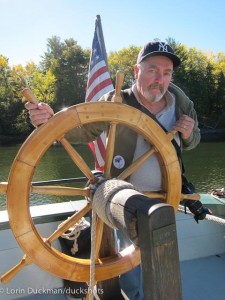
Jay Maisel told a story about Snowflake Bentley at the Maine Media workshop I attended. Allegedly, Snowflake Bentley was being honored by a photographic society at a fancy hotel in NYC. During the awards ceremony, as he was about to speak, he learned that snow had begun to fall. He announced to the crowd that he had to be going, picked up his camera, and left.
So Jay lives in the heart of museum country. I don’t. He loves to see the work of others, framed or just published. And he loves to teach, sharing with others his passion for making images and his love of art. So when I read the January 3, 2011 New Yorker article on snowflakes that referred to Snowflake Bentley, a photographer of note whom I had only learned of from him, who, as Adam Gopnik pointed out lived in Vermont, I went to the museum in the next town which houses his equipment and work.
Thanks Jay. Who knew it was just up the road a piece.